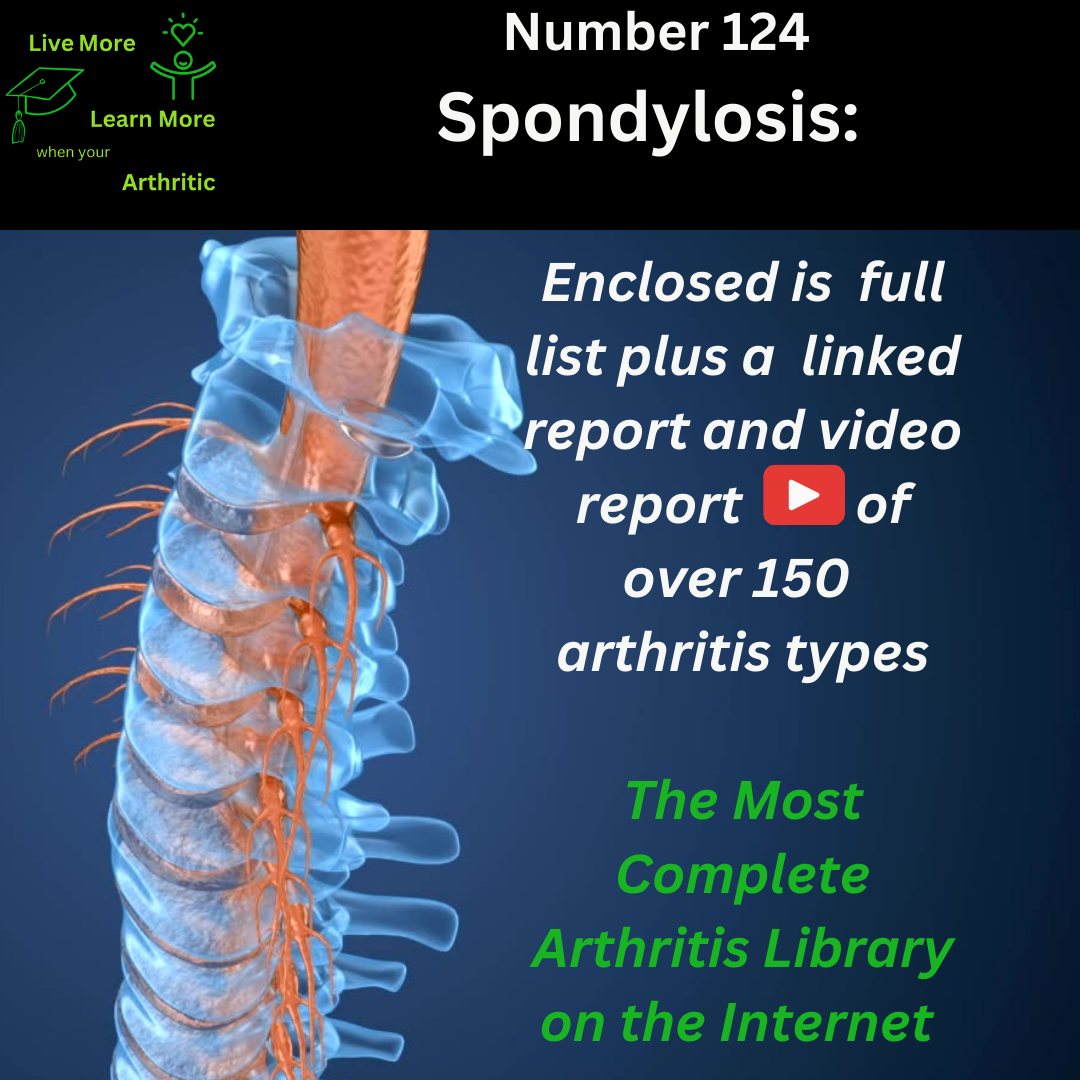
Spondylosis: Number 124 of around 150 types of Arthritis
Exploring Spondylosis: The Back Story
Ah, spondylosis—a condition that’s not as glamorous as it sounds! This term refers to the natural wear and tear of the spine that occurs with age. The parts of the spine most commonly affected by spondylosis are the intervertebral discs, which act as cushions between the vertebrae, and the facet joints that link the vertebrae together. As we age, these discs lose water content and become less flexible, leading to changes like bone spurs and reduced disc height.
 Chance of Remission and Description of the Disease
Chance of Remission and Description of the Disease
Spondylosis is a chronic condition, meaning it doesn’t usually go into full remission like a cold or flu might. However, with the right management strategies, symptoms can often be controlled and quality of life improved. This condition is often referred to as degenerative disc disease or osteoarthritis of the spine.
Causes and Triggers of Spondylosis
The primary cause of spondylosis is age-related degeneration, but certain factors can accelerate its onset. These include repetitive stress on the spine from activities like heavy lifting or poor posture, obesity, and genetic factors that affect the integrity of spinal structures. Trauma from accidents or sports injuries can also trigger spondylosis at a younger age.
Symptoms and Range of Motion
The hallmark symptoms of spondylosis include stiffness and pain in the neck or lower back, which may radiate to the arms or legs if nerves are affected. Limited range of motion and difficulty bending or twisting are common. Pain can be intermittent or chronic, varying in intensity depending on activity level and posture.
Onset Ages and Lifespan Changes
Spondylosis typically becomes noticeable in people over the age of 40, though it can manifest earlier in individuals with predisposing factors. While spondylosis itself doesn’t directly shorten lifespan, it can significantly impact quality of life and mobility, leading to secondary complications like reduced physical activity and associated health issues.
Is Spondylosis an Autoimmune Condition?
No, spondylosis is not considered an autoimmune form of arthritis. Unlike rheumatoid arthritis or ankylosing spondylitis, which involve immune system dysfunction, spondylosis is primarily a result of mechanical stress and age-related changes in spinal structures.
Risk Factors and Complications
Risk factors for spondylosis include advancing age, obesity, sedentary lifestyle, occupations involving heavy lifting or repetitive bending, and genetic predisposition. Complications may include herniated discs, spinal stenosis (narrowing of the spinal canal), and compression of spinal nerves leading to pain, weakness, or numbness in extremities.
Inflammation and Joint Tenderness
Inflammation is not a primary factor in spondylosis; however, it can occur secondary to irritation of tissues surrounding affected spinal structures. Joint tenderness may result from pressure on nerves or surrounding soft tissues due to bone spurs or disc degeneration.
Role of Comorbidities and Range of Motion Loss
Comorbidities such as obesity or metabolic disorders can exacerbate spondylosis by placing additional strain on spinal structures. Loss of range of motion occurs due to stiffening of intervertebral discs and facet joints, limiting the spine’s flexibility and affecting mobility.
Improving Quality of Life with a Proactive Approach
Yes, a proactive approach can significantly enhance quality of life for individuals with spondylosis. This includes maintaining a healthy weight to reduce strain on the spine, practicing good posture and ergonomic techniques, engaging in regular low-impact exercise like swimming or yoga, and seeking prompt medical attention for pain management or symptom exacerbation.
Possible Complications and Common Age of Onset
Complications of spondylosis include chronic pain, reduced mobility, and increased risk of falls or injuries due to impaired balance and coordination. The condition predominantly affects older adults, with onset typically occurring after the age of 40, though earlier onset can occur in those with predisposing factors.
 Gender Disparities and Interconnected Conditions
Gender Disparities and Interconnected Conditions
Spondylosis affects both men and women, but the prevalence may vary slightly between genders. Women may experience hormonal changes that influence bone density and spinal health, potentially impacting the progression of spondylosis. Interconnected conditions include osteoarthritis in other joints, cardiovascular disease due to reduced physical activity, and mental health issues related to chronic pain and mobility limitations.
In summary, while spondylosis presents challenges, proactive management strategies and lifestyle modifications can significantly enhance quality of life and mitigate the impact of this condition on daily activities and overall well-being. Understanding the causes, symptoms, and risk factors of spondylosis empowers individuals to take control of their health and pursue interventions that promote spinal health and mobility throughout life.

